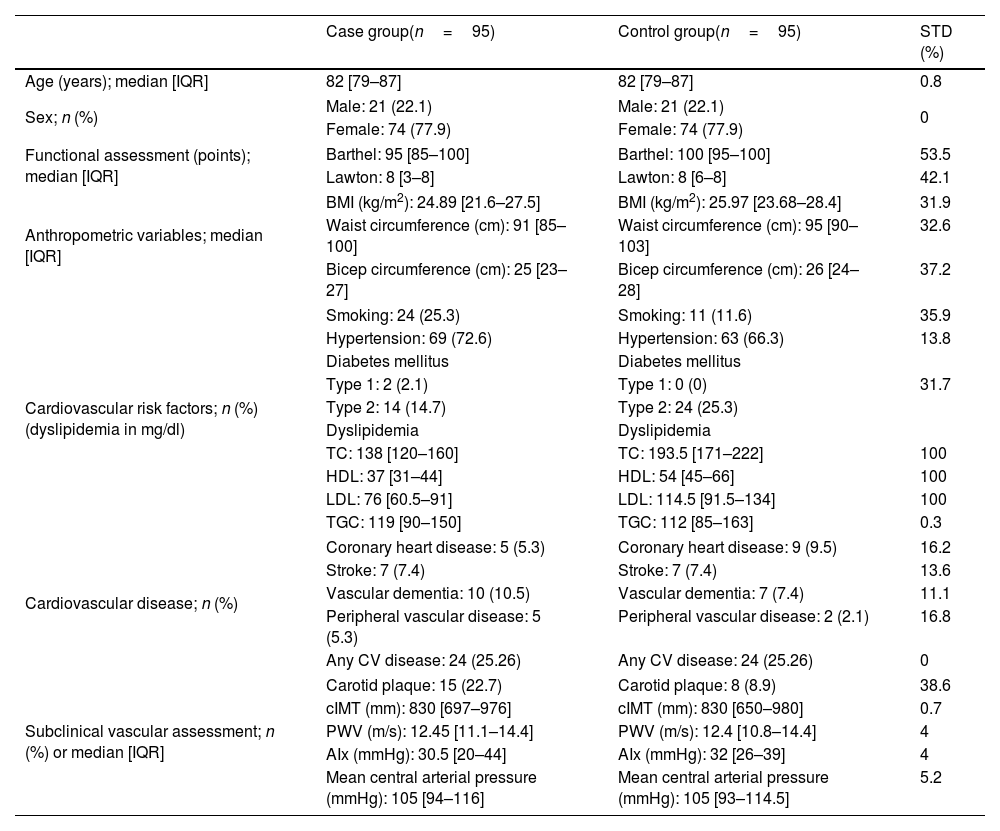Evaluate clinical and subclinical arteriosclerotic disease in older patients with hip fracture compared with patients without fracture in order to increase knowledge about the relation between both diseases in older individuals.
Patients and methodsAge- and sex-matched case–control study of octogenarians with and without recent hip fracture. Vascular risk factors, subclinical vascular diseases (assessed by carotid plaques, carotid intima media thickness and arterial stiffness) as well as cardiovascular diseases were analyzed. Univariate and multivariate logistic models were used to estimate odds ratios (OR) with their 95% confidence intervals (CI) to assess the association of the arteriosclerosis and hip fracture.
ResultsWe analyzed 95 patients per group with a median age of 82 [79–87] years of whom 77.9% were female. Patients in both groups have elevated rates of vascular disease (25%) without differences between them. Patients with hip fracture had higher subclinical arteriosclerotic alterations with higher percentage of carotid plaques (OR 3.25 [1.06–9.97]) compared with the control group.
ConclusionsOlder patients with hip fracture had significantly higher presence of subclinical alterations but not increase on rate of cardiovascular arteriosclerotic disease compared with those without hip fracture.
Evaluar la enfermedad arteriosclerótica clínica y subclínica en pacientes mayores con fractura de cadera en comparación con pacientes sin fractura previa con el fin de aumentar el conocimiento sobre la relación entre ambas enfermedades en personas mayores.
Pacientes y métodosEstudio de casos y controles emparejados por edad y sexo de octogenarios con y sin fractura de cadera reciente. Se analizaron los factores de riesgo vascular, las enfermedades vasculares subclínicas (evaluadas mediante placas carotídeas, el espesor de la íntima media carotídea y la rigidez arterial), así como las enfermedades cardiovasculares. Se utilizaron modelos logísticos univariados y multivariados para estimar los odds ratios (OR) con sus intervalos de confianza (IC) del 95% para evaluar la asociación entre arteriosclerosis y fractura de cadera.
ResultadosSe analizaron 95 pacientes por grupo con una mediana de edad de 82 años [79-87], de los cuales el 77,9% eran mujeres. Los pacientes de ambos grupos presentan tasas elevadas de enfermedad vascular (25%) sin diferencias entre ellos. Los pacientes con fractura de cadera tuvieron mayores alteraciones arterioscleróticas subclínicas con mayor porcentaje de placas carotídeas (OR 3,25 [1,06-9,97]) en comparación con el grupo control.
ConclusionesLos pacientes de mayor edad con fractura de cadera tuvieron una presencia significativamente mayor de alteraciones subclínicas, pero no un aumento en la tasa de enfermedad arteriosclerótica cardiovascular en comparación con aquellos sin fractura de cadera.








